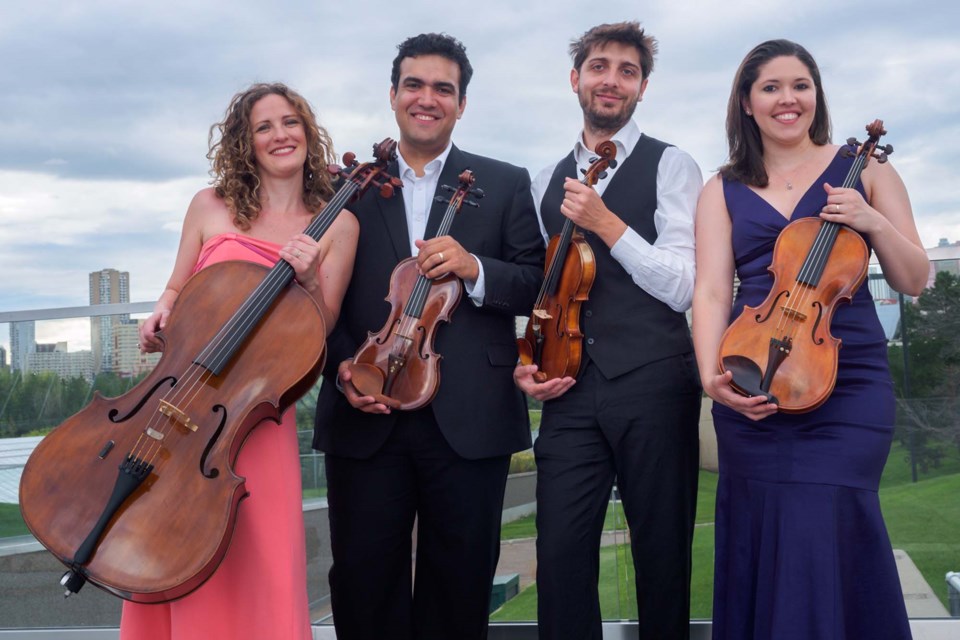String quartets are some of the most mobile musicians around — they can easily pick up their instruments and move quickly from one venue to another. They quietly appear, greet their audience, do their thing, and slip away into the night.
Performances tend to be tricky when half of the quartet lives in Edmonton and the other half in Montreal. Somehow the Vaughn String Quartet has made it work as one of the most in-demand quartets in the province.
Cellist Silvia Buttiglione and her husband violinist Mattia Berrini moved to Montreal in 2019 to broaden their studios. Buttiglione is working towards a law degree while Berrini is pursuing a doctorate in violin performance.
Meanwhile in Edmonton first violinist Vladimir Rufino and violist Fabiola Amorim are fielding calls and booking local performances, such as the one hosted by the St. Albert Chamber Music Society on Saturday, May 7, at St. Albert United Church.
“We are extremely happy to be back with the St. Albert Chamber Music Society. It is our third or fourth time. Nancy (Watt) is an amazing person, and she has connected [us] with so many musicians. When we perform, we always try to bring something different and there are always new experiences to share,” said Amorim.
Despite the long-distance relationship, no group has been busier keeping a rigorous schedule rehearsing privately and virtually as group as well as teaching and performing online.
“When we get together, we meet for 10 or 12 days and rehearse from 9 a.m. to late at night. We know our individual parts and concentrate on rehearsing as a group.”
The string quartet presents four uniquely diverse compositions from Brazilian composers Beetholven Cunha and Marcilio Onofre to Italian composers Nino Rota and Giuseppe Verdi.
From the start, the quartet’s mission was to introduce a gold-standard repertoire written by internationally famous composers who may be less known in the region. Except for Verdi, the other three composers are less recognized locally despite worldwide acclaim.
The program opens with the world premiere of Cunha’s Quartet No. 6, a four-movement composition specifically written for the quartet.
“He is the most prominent composer from Brazil. We have always followed him, and some friends introduced him. We chatted about a collaboration, and he offered to compose something for us,” said Amorim.
“In this composition, he collects elements from traditional pieces of Brazilian music and uses rustic effects. He uses a pizzicato (plucking) and the rhythm patterns are not traditional classical music. There is syncopation, which is dance music. And we use wood sounds, clapping or tapping our instrument.”
Onofre’s Immigrant Quartet “Skeletons” instead swings towards the more modern, economic compositional style.
“This piece is the most contemporary. It is very fragmented. He uses some of the same music, but it is not minimalist. He does not have a traditional sense of tonality. It does not follow the same patterns as traditional music. As a performance it is a gamble. We do not know how it will be received, but we have to bring to the audience what is happening in the present.”
Rota’s Quartetto Per Archi (Quartet for Bows) is a three-movement work that begins with a moderately lively tempo, and shifts towards a slow, poignant character before finishing on a cheerfully robust note.
“He utilizes melodic material. He is very rhythmical, very clean. You understand each instrument and they sometimes play something different. It is like a conversation.”
The quartet completes its segment with String Quartet in E Minor, Verdi’s one and only surviving string quartet considered to be quite technically challenging.
“He mostly wrote for operas. It’s a fugue, one of the most challenging. All the instruments have different thematic materials. As a fugue it has very thick lines but later there are light sounds like a dance."
The program opens with a performance from emerging artist, violinist Aidan Lai, 17. The Grade 11 Paul Kane High School student plays the lush Chaconne in G Minor by Italian composer Tomaso Antonio Vitali. Aidan's sister Justine accompanies him on piano.
“It’s an extremely dramatic piece. It’s a Baroque piece, but many composers have edited it and it has a romantic passion to it,” said Aidan. “There are lots of multiple voices. It’s more of a story than just something pleasant to listen to.”
Doors open Sunday, May 7, at 6:45 p.m. The concert starts at 7 p.m. at 20 Green Grove Dr. Tickets are $35/adults, $30/seniors, and $15/students. Visit www.eventbrite.ca or at Musée Heritage Museum until noon on concert day.




